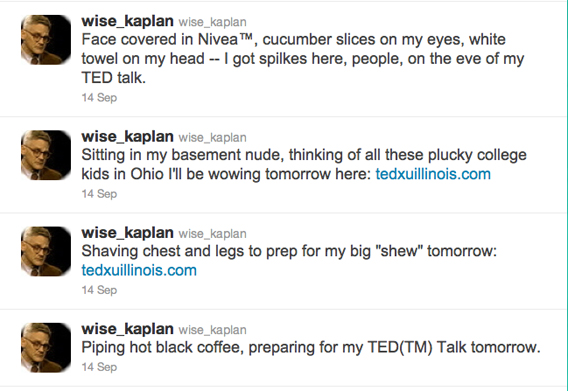















September 22, 2011 | permalink

We had a first, of sorts, at last week’s TEDxUIllinois – the first TED Talk delivered by a fictional Twitter character. The character in question was @Wise_Kaplan, the brainchild of former New York Observer editors Jim Windolf and Peter Stevenson, who modeled him (and his twin @Cranky_Kaplan) on their former boss, legendary newspaper editor Peter Kaplan (who may or may not be tweeting himself under @Real_Kaplan… and @Kaplan_Premium). Confused? Don’t be.
Wise and Cranky were an inside joke for New York media reporters until Slate verified their creators’ idenities in a story last year. What started as a diversion blossomed into a pair of endless picaresques told in 140-character installments:
Wise and Cranky are the children of a lost New York. From breakfast until deep into the night, they travel back and forth between the city and the bedroom community of Larchmont, N.Y., charting a path among Manhattan’s decaying cultural landmarks and greasy-spoon diners. Their heroes are the ghosts of jazz greats, long-dead stylists, and midcentury entertainers. In another time, Wise Kaplan and his démodé tastes might have found a home in the pages of a dime novel: The character is self-possessed but chronically bemused, the sort of guy who has just re-emerged into the world after decades in his own head. Stevenson and Windolf describe him as “all anxiety.”
Over the summer, an anxious Wise lamented publicly that he had never received a major award or invited to give a TED Talk. So I invited him to speak at TEDxUIllinois, naturally. Windolf and Stevenson were game, and we settled on one of Wise’s recurring motifs – “Lessons in Journalism,” a rapid-fire series of tweets espousing hilariously cynical advice (“An easy way to become an online star is to make like the Internetâ„¢ is beneath you”) and non sequiturs (“Hire a guy to slip drugs into your coffee every morning”). We arranged that Wise would address the crowd live, “in-person.” The audience reaction was… puzzled.
(The complete @Wise_Kaplan TED Talk is after the jump.)
Some audience members were unfamiliar with the fake Twitter character concept altogether, while others avidly followed satire accounts like @MayorEmanuel, which riff off the news to provide context. But many seemed taken aback by Wise’s double-barreled stream-of-consciousness. (Although there may have been an age gap in effect: the kids got it, but the olds didn’t.)
Video of @Wise_Kaplan’s talk, along with a concurrent audience Q&A with Pew’s Lee Rainie and Race After The Internet editor Lisa Nakamura will be posted later, but for now, scroll down to the bottom to read his pre-, post- and TED Talk tweets in their entirety.


» Folllow me on Twitter.
» Email me.
» See upcoming events.

Greg Lindsay is a generalist, urbanist, futurist, and speaker. He is a non-resident senior fellow of the Arizona State University Threatcasting Lab, a non-resident senior fellow of MIT’s Future Urban Collectives Lab, and a non-resident senior fellow of the Atlantic Council’s Scowcroft Strategy Initiative. He was the founding chief communications officer of Climate Alpha and remains a senior advisor. Previously, he was an urban tech fellow at Cornell Tech’s Jacobs Institute, where he explored the implications of AI and augmented reality at urban scale.

January 31, 2024
Unfrozen: Domo Arigatou, “Mike 2.0”
January 22, 2024
The Future of Generative AI in Architecture, Engineering, and Construction
January 18, 2024
The Promise and Perils of the Augmented City
January 13, 2024
Henley & Partners: Generative AI, Human Labor, and Mobility

----- | January 22, 2024
The Future of Generative AI in Architecture, Engineering, and Construction
----- | January 1, 2024
----- | August 3, 2023
CityLab | June 12, 2023
Augmented Reality Is Coming for Cities
CityLab | April 25, 2023
The Line Is Blurring Between Remote Workers and Tourists
CityLab | December 7, 2021
The Dark Side of 15-Minute Grocery Delivery
Fast Company | June 2021
Why the Great Lakes need to be the center of our climate strategy
Fast Company | March 2020
How to design a smart city that’s built on empowerment–not corporate surveillance
URBAN-X | December 2019
CityLab | December 10, 2018
The State of Play: Connected Mobility in San Francisco, Boston, and Detroit
Harvard Business Review | September 24, 2018
Why Companies Are Creating Their Own Coworking Spaces
CityLab | July 2018
The State of Play: Connected Mobility + U.S. Cities
Medium | May 1, 2017
Fast Company | January 19, 2017
The Collaboration Software That’s Rejuvenating The Young Global Leaders Of Davos
The Guardian | January 13, 2017
What If Uber Kills Public Transport Instead of Cars
Backchannel | January 4, 2017
The Office of the Future Is… an Office
New Cities Foundation | October 2016
Now Arriving: A Connected Mobility Roadmap for Public Transport
Inc. | October 2016
Why Every Business Should Start in a Co-Working Space
Popular Mechanics | May 11, 2016
Can the World’s Worst Traffic Problem Be Solved?
The New Republic | January/February 2016